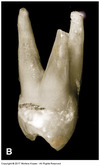Ch 11 Dental Anomalies Flashcards
(51 cards)
What dental anomaly is represented here?

partial anodontia
What dental anomaly is represented here?

partial anodontia
What dental anomaly is represented here?

partial anodontia
What dental anomaly is represented here?

Supernumerary mesiodens
What dental anomaly is represented here?

Supernumerary mesiodens
What dental anomaly is represented here?

(supernumerary) fourth molars
What dental anomaly is represented here?

peg-shaped maxillary lateral incisor
What dental anomaly is represented here?

Gemination (twinning)
It appears that the tooth germ for tooth #23 split or divided into two. The geminated tooth will generally have a single root and common pulp canal.
What dental anomaly is represented here?

Fusion.
Two teeth appear to be fused together. There are two pulp canals.
What dental anomaly is represented here?

Fusion
What dental anomaly is represented here?

Fusion
What dental anomaly is represented here?

Hutchinson incisors
effects of congenital syphilis
What dental anomaly is represented here?

mulberry molar
effects of congenital syphilis
What dental anomaly is represented here?

Extra cusps
What dental anomaly is represented here?

Tuberculum intermedium
Mandibular first and second molars with extra, midlingual cusps, each called a tuberculum intermedium.
What dental anomaly is represented here?

Talon cusps
The lingual defects in all of these teeth could affect the occlusion.
What dental anomaly is represented here?

Tubercles
Elevations or tubercles (or cusplets) on the cingula of a canine and lateral incisor.
What dental anomaly is represented here?

Unusually prominent labial ridge
What dental anomaly is represented here?

Macrodontia
(of very long incisors)
What dental anomaly is represented here?

Microdontia
(of three very short central incisors with dwarfed roots)
What dental anomaly is represented here?

Shovel-shaped
permanent incisors
*More common in American Indians
What dental anomaly is represented here?

Enamel pearls
on maxillary molar roots, many located near the furcation.
What dental anomaly is represented here?

Taurodontia
bull or “prism” teeth, very long pulp chamber, without a constriction near the CEJ
What dental anomaly is represented here?

Dilaceration
dilaceration (or flexion) of the root.
























